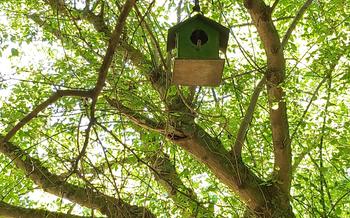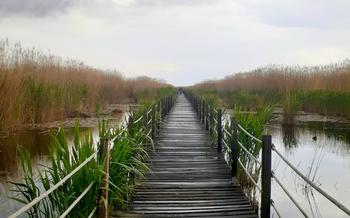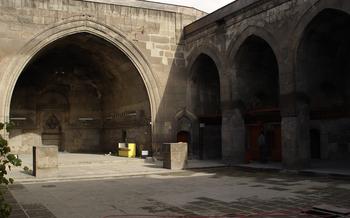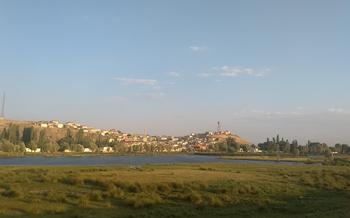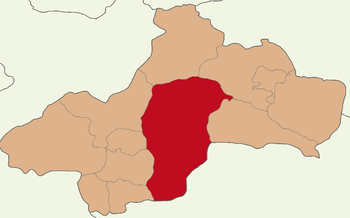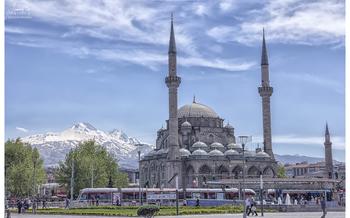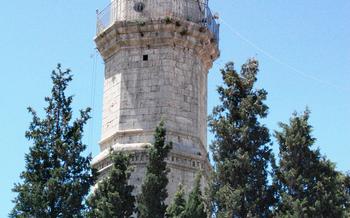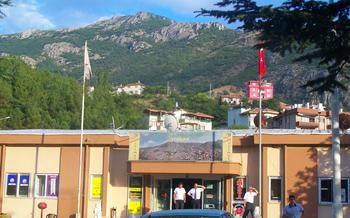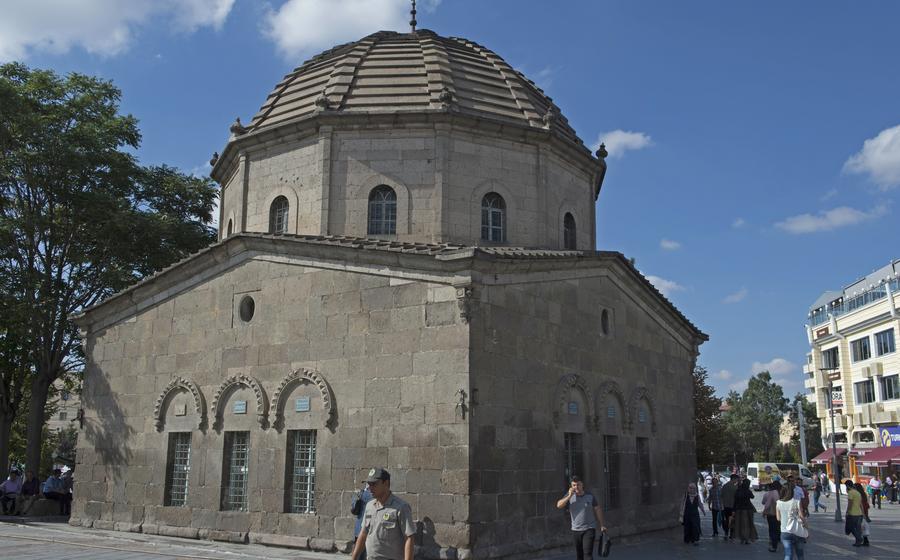
Zeynel Abidin Mosque and Tomb
- Zeynel Abidin Mosque and Tomb: A Spiritual and Architectural Masterpiece
- Location and Accessibility: Finding Your Way to Zeynel Abidin
- Unveiling the History: A Journey Through Time
- Architectural Marvels: Exploring the Complex
- Zeynel Abidin's Legacy: A Man of Piety and Knowledge
- Mesmerizing Interior: A Feast for the Eyes
- A Place of Worship and Reflection
- UNESCO World Heritage Site: Recognizing Global Significance
- Pilgrimage and Religious Tourism
- Local Traditions and Customs: Discovering the Culture
- Respectful Attire and Behavior: A Guide for Visitors
- Photography and Documentation: Capturing Memories
- Local Cuisine and Delicacies: A Culinary Journey
- Combining History and Nature: Exploring Nearby Sites
- Insider Tip: Unveiling Hidden Treasures
Zeynel Abidin Mosque and Tomb: A Spiritual and Architectural Masterpiece
The Zeynel Abidin Mosque and Tomb, located in the heart of Kayseri, Turkey, stands as a testament to the city's rich history and vibrant Islamic heritage. The mosque, adorned with intricate tilework and calligraphy, is a masterpiece of Seljuk architecture, while the tomb, housing the remains of the revered Islamic scholar Zeynel Abidin, exudes an aura of spirituality and tranquility. Together, they form a complex that is not only a place of worship but also a significant pilgrimage site for Muslims worldwide.
The mosque was built in the 13th century by the Seljuk Sultan Alaeddin Keykubad I and is dedicated to the memory of Zeynel Abidin, a renowned Islamic scholar and mystic. The tomb, located adjacent to the mosque, was constructed later in the 14th century. The complex has undergone several renovations over the centuries but has retained its original architectural integrity and spiritual significance.
Location and Accessibility: Finding Your Way to Zeynel Abidin
The Zeynel Abidin Mosque and Tomb are situated in the heart of Kayseri, Turkey. Their precise address is Cumhuriyet Meydanı, Talas, Kayseri. Reaching this sacred complex is relatively straightforward. Visitors can opt for public transportation, which offers convenient access to the site. Numerous buses and trams have stops near the mosque, making it easily accessible from various parts of the city. For those preferring private transportation, the mosque provides ample parking space, ensuring a hassle-free visit.
Once you arrive in the vicinity, you will be greeted by the imposing presence of the mosque and tomb. Their grand architecture and serene ambiance create an aura of tranquility that draws visitors in. As you approach the complex, take a moment to admire its majestic facade, adorned with intricate tilework and calligraphy. Prepare to be captivated by the harmonious blend of history, spirituality, and architectural brilliance that awaits you within the walls of this sacred site.
Unveiling the History: A Journey Through Time
The Zeynel Abidin Mosque and Tomb, nestled in the heart of Kayseri, Turkey, holds a rich history that spans centuries. Its origins can be traced back to the 13th century when the renowned Sufi saint, Zeynel Abidin, chose this site for his spiritual retreat and eventual resting place. Zeynel Abidin, a revered figure in Islamic mysticism, dedicated his life to teaching and guiding his disciples. His profound wisdom and teachings attracted followers from far and wide, solidifying his reputation as a spiritual leader.
Over time, the mosque and tomb evolved into a significant religious and cultural center. In the 16th century, the Ottoman Sultan Suleiman the Magnificent ordered the renovation and expansion of the complex, reflecting its growing importance. The mosque's design and architecture were refined, incorporating elements of Ottoman style, while preserving its original Seljuk foundations. The tomb, where Zeynel Abidin's mortal remains lie, became a pilgrimage site for his devoted followers and a place of veneration for Muslims seeking spiritual guidance.
Throughout history, the Zeynel Abidin Mosque and Tomb witnessed numerous events and transformations. It served as a place of worship, a center for Islamic learning, and a sanctuary for those seeking solace and spiritual connection. Its enduring legacy and historical significance have made it a cherished landmark, not only for the people of Kayseri but for Muslims worldwide.
Architectural Marvels: Exploring the Complex
The Zeynel Abidin Mosque and Tomb stands as a testament to the architectural prowess of its era. Its distinctive style blends Seljuk and Ottoman influences, showcasing a harmonious fusion of traditional and innovative elements. The mosque's layout follows the classical arrangement, featuring a rectangular prayer hall flanked by two minarets. The interior space is defined by a series of elegant columns and arches, creating a sense of grandeur and spaciousness.
The tomb, located adjacent to the mosque, exhibits a more intricate design. Its octagonal shape is adorned with intricate tilework and decorative motifs, reflecting the artistic sensibilities of the period. The tomb's interior features a cenotaph, a symbolic representation of Zeynel Abidin's resting place, which is elaborately decorated with Quranic verses and geometric patterns.
The mosque's minarets, towering over the surrounding landscape, are architectural masterpieces in their own right. Their slender forms, adorned with intricate carvings and tilework, serve as a testament to the skill and precision of the builders. The minarets' balconies, accessible via spiral staircases, offer panoramic views of the city, providing visitors with a breathtaking perspective of Kayseri.
Overall, the Zeynel Abidin Mosque and Tomb is an architectural marvel that seamlessly blends historical, cultural, and religious influences. Its unique design elements and intricate details make it a must-visit destination for anyone interested in Islamic architecture and history.
Zeynel Abidin's Legacy: A Man of Piety and Knowledge
Zeynel Abidin, the namesake of the mosque and tomb, was a revered figure in Islamic history. Born in Kayseri in the 14th century, he gained prominence as a scholar, theologian, and spiritual guide. His teachings and writings focused on Islamic law, ethics, and mysticism, earning him a reputation for wisdom and piety. Zeynel Abidin's influence extended beyond Kayseri, attracting students and followers from across the region. His legacy continues to inspire Muslims to this day, with his tomb serving as a site of pilgrimage and veneration.
Mesmerizing Interior: A Feast for the Eyes
Step inside the Zeynel Abidin Mosque and Tomb, and you'll be greeted by an interior that is as captivating as it is serene. Intricate tilework adorns the walls, with vibrant colors and harmonious patterns creating a mesmerizing visual tapestry. Geometric designs dance across the surfaces, showcasing the artistry and craftsmanship of the era.
The ceiling, a masterpiece in itself, features intricate calligraphy, with verses from the Quran beautifully inscribed in elegant Arabic script. The harmonious blending of colors, patterns, and calligraphy creates a spiritual atmosphere that invites contemplation and reflection.
The tomb of Zeynel Abidin, located within the complex, is equally impressive. Its interior is adorned with exquisite carvings and decorative motifs, paying homage to the man who dedicated his life to Islamic teachings. The serene ambiance of the tomb, coupled with the intricate artistry, creates a space for quiet contemplation and remembrance.
A Place of Worship and Reflection
The Zeynel Abidin Mosque serves as a significant place of worship for Muslims in the Kayseri region. Daily prayers are held within the mosque's spacious prayer hall, where the faithful gather to perform their religious obligations. The serene and peaceful ambiance of the mosque creates an ideal environment for contemplation and connection with the divine.
Adjacent to the mosque lies the tomb of Zeynel Abidin, a revered figure in Islamic history. The tomb serves as a site for remembrance and reflection, where visitors pay their respects and seek blessings. The tranquil atmosphere of the tomb invites contemplation on the life and teachings of Zeynel Abidin, inspiring feelings of spirituality and reverence among those who visit.
UNESCO World Heritage Site: Recognizing Global Significance
The Zeynel Abidin Mosque and Tomb have been recognized for their exceptional cultural and historical value by being inscribed on the UNESCO World Heritage List. This prestigious designation is a testament to the site's outstanding universal value, which is determined based on specific criteria set by UNESCO.
The mosque and tomb meet several of these criteria, including their representation of a unique architectural style that has had a significant impact on the development of Islamic architecture. They also showcase remarkable craftsmanship and artistic achievements, evident in the intricate tilework, calligraphy, and decorative elements that adorn the complex.
Furthermore, the site holds immense religious significance for Muslims worldwide, as it is associated with the life and legacy of Zeynel Abidin, a revered figure in Islamic history. The mosque and tomb have become a place of pilgrimage and spiritual connection for millions of Muslims, who visit to pay their respects and seek blessings.
By being included on the UNESCO World Heritage List, the Zeynel Abidin Mosque and Tomb have gained international recognition and protection. This designation ensures that the site will be preserved and managed in a sustainable manner, allowing future generations to appreciate its cultural and historical significance.
Pilgrimage and Religious Tourism
The Zeynel Abidin Mosque and Tomb hold immense significance for Muslim pilgrims, attracting countless visitors from around the world. The site's spiritual aura and historical importance make it a popular destination for those seeking religious enlightenment and a connection to their faith. Incorporating the mosque and tomb into religious tours has become increasingly common, offering pilgrims an opportunity to explore the sacred spaces and delve deeper into Islamic history and culture. Visitors can embark on guided tours that provide insights into the site's religious significance, its architectural features, and the life of Zeynel Abidin. These tours often combine visits to other important religious sites in Kayseri, creating a comprehensive and enriching experience for pilgrims. The opportunity to pray within the mosque's serene atmosphere and to pay homage at Zeynel Abidin's tomb offers a profound and deeply moving experience for Muslim visitors, leaving a lasting spiritual impact.
Local Traditions and Customs: Discovering the Culture
The Zeynel Abidin Mosque and Tomb are deeply embedded in the cultural fabric of Kayseri. Local traditions and customs play a vital role in shaping the interactions and experiences at the site. Visitors are encouraged to embrace these customs respectfully to gain a deeper understanding of the local culture.
One significant tradition is the practice of removing shoes before entering the mosque. This act symbolizes purity and respect for the sacred space. Visitors are expected to follow this custom and leave their footwear in the designated shoe racks provided.
Another tradition is the act of bowing and making dua (supplication) upon entering the mosque. This gesture expresses humility and reverence towards Allah. Visitors are welcome to participate in this practice as a sign of respect for the religious significance of the site.
The community surrounding the mosque and tomb holds these traditions in high regard. Locals often visit the site for daily prayers, religious ceremonies, and special occasions. Visitors can witness these events and interact with locals to gain insights into their faith and cultural practices.
Engaging with local vendors and artisans near the site is another way to experience the local culture. Visitors can find traditional Turkish handicrafts, souvenirs, and delicacies, contributing to the vibrant atmosphere of the area.
By embracing local traditions and customs, visitors can immerse themselves in the rich cultural heritage of Kayseri and create a truly memorable and meaningful experience at the Zeynel Abidin Mosque and Tomb.
Respectful Attire and Behavior: A Guide for Visitors
When visiting the Zeynel Abidin Mosque and Tomb, it is essential to observe appropriate dress code and behavior out of respect for local customs and religious sensitivities. Visitors should dress modestly, with clothing that covers their shoulders and knees. Revealing or tight-fitting clothing is discouraged. For women, it is recommended to cover their heads with a headscarf as a sign of respect.
Upon entering the mosque, visitors should remove their shoes and place them in the designated shoe racks. It is customary to perform ablution before entering the prayer hall. Ablution facilities are usually available near the entrance of the mosque.
Inside the mosque, visitors should maintain a respectful demeanor and avoid loud conversations or disruptive behavior. It is considered disrespectful to walk in front of someone who is praying or to interrupt their prayers in any way. Visitors should also be mindful of the sanctity of the site and refrain from taking photographs or using their mobile phones during prayers.
When visiting the tomb, visitors should approach with reverence and humility. It is customary to recite prayers or supplications for the deceased. Visitors should avoid touching or leaning against the tomb itself and maintain a respectful distance.
By observing proper etiquette and respecting local customs, visitors can contribute to the preservation of the sacred atmosphere of the Zeynel Abidin Mosque and Tomb and ensure a meaningful and respectful experience for all.
Photography and Documentation: Capturing Memories
When visiting the Zeynel Abidin Mosque and Tomb, capturing the beauty and essence of the site through photography is a natural desire. However, it is important to respect the sanctity of the religious site and adhere to guidelines for documentation.
Photography is generally permitted within the mosque and tomb, but visitors should be mindful of the privacy of worshippers and avoid causing any disruption. Using a flash or tripod may not be allowed, and visitors should seek permission from the mosque's caretakers or officials before setting up any equipment.
When taking photographs, focus on capturing the architectural details, intricate tilework, and serene atmosphere of the site. Respect the privacy of individuals and avoid taking intrusive or disrespectful shots. Maintaining a respectful and solemn demeanor is essential, as the mosque and tomb are places of worship and contemplation.
For those seeking more comprehensive documentation, it is advisable to inquire about any restrictions or permit requirements. Special events or exhibitions may have specific guidelines, and obtaining the necessary permissions will ensure a smooth and respectful visit.
By following these guidelines and respecting local customs, visitors can capture lasting memories of their visit to the Zeynel Abidin Mosque and Tomb, preserving the beauty and significance of this sacred site for generations to come.
Local Cuisine and Delicacies: A Culinary Journey
A visit to Kayseri is not complete without savoring the local cuisine. The city is renowned for its delicious dishes, and the area surrounding the Zeynel Abidin Mosque and Tomb offers a diverse culinary experience.
Strolling along the charming streets, visitors will find an array of restaurants and eateries catering to various tastes. For a traditional Turkish breakfast, try the famous "menemen," a dish of scrambled eggs with tomatoes, peppers, and spices. Accompany it with freshly baked bread and a glass of Turkish tea for a delightful start to the day.
For lunch or dinner, indulge in Kayseri's specialty, "mantı." These small dumplings, filled with minced meat and topped with yogurt sauce, garlic, and paprika butter, are a local delicacy not to be missed. The flavors blend harmoniously, creating a dish that is both comforting and satisfying.
Vegetarians will delight in the variety of meze, or small appetizers, available at local restaurants. From hummus and baba ghanoush to yaprak sarma (stuffed vine leaves) and çiğ köfte (raw meatballs), there are plenty of options to choose from. Each bite offers a burst of flavor and a glimpse into Turkish culinary traditions.
Sweets lovers should try Kayseri's famous "katmer," a flaky pastry filled with pistachio nuts and drizzled with honey. The crispy layers and sweet filling make it an irresistible treat.
To accompany your meal, sip on a glass of şalgam suyu, a fermented turnip juice that is a local favorite. Its unique, slightly sour taste pairs well with the rich flavors of Turkish cuisine.
Whether you prefer a traditional Turkish breakfast, a hearty lunch, or a sweet treat, the area surrounding the Zeynel Abidin Mosque and Tomb offers a culinary journey that will tantalize your taste buds and leave you craving for more.
Combining History and Nature: Exploring Nearby Sites
While delving into the rich history and spiritual significance of the Zeynel Abidin Mosque and Tomb, take the opportunity to explore the captivating surroundings that Kayseri offers. Just a stone's throw away, discover the iconic Erciyes Mountain, a dormant volcano that beckons outdoor enthusiasts with its scenic hiking trails and winter sports facilities. Ascend to its peak and witness breathtaking panoramic views of the city and the surrounding landscapes.
For a glimpse into Kayseri's rich cultural heritage, visit the Kayseri Castle, a majestic fortress that has stood the test of time. Explore its imposing walls, wander through its intriguing chambers, and delve into the tales of its glorious past. The castle offers a captivating journey through history, providing a glimpse into the lives of ancient civilizations that once called this region home.
Nature lovers will find solace in the lush greenery of the Kayseri Botanical Park, a haven of tranquility that showcases a diverse collection of plant life. Stroll along its winding paths, admire the vibrant blooms, and immerse yourself in the serene ambiance of this natural oasis.
To fully appreciate the region's rich tapestry of history and culture, consider embarking on a guided tour. Local experts can provide insightful commentary, bringing to life the stories and legends that have shaped Kayseri's identity. These tours offer a comprehensive exploration of the city's landmarks, ensuring you don't miss any hidden gems.
By combining your visit to the Zeynel Abidin Mosque and Tomb with explorations of these nearby sites, you'll create a well-rounded and memorable travel experience that encompasses history, nature, and cultural immersion.
Insider Tip: Unveiling Hidden Treasures
Beyond the mosque's captivating interior and the serene ambiance of the tomb, the Zeynel Abidin complex holds hidden treasures waiting to be discovered. One such gem is the intricate tilework adorning the exterior walls. These tiles, often overlooked by visitors, showcase exquisite patterns and vibrant colors that add a unique charm to the structure.
For photography enthusiasts, capturing the mosque and tomb from the rooftop of the nearby madrasah offers a breathtaking panoramic view. This vantage point allows you to capture the grandeur of the complex against the backdrop of Kayseri's cityscape.
If you visit during the annual Mevlid-i Nebi festival, celebrating the birth of Prophet Muhammad, the mosque and tomb come alive with special events and activities. This festival draws thousands of pilgrims and offers a unique opportunity to immerse yourself in the spiritual and cultural traditions of the region.
